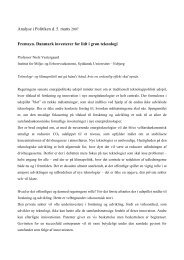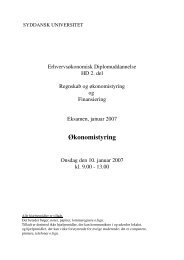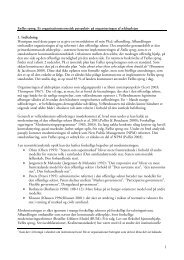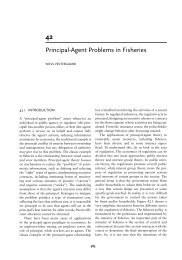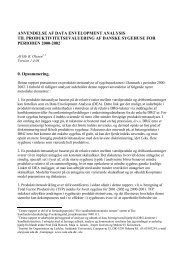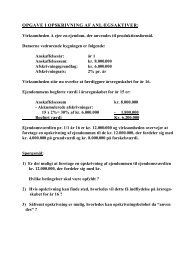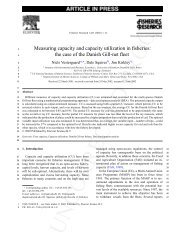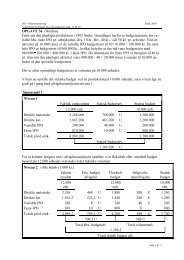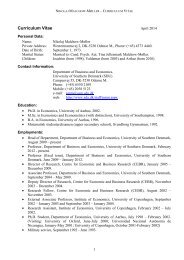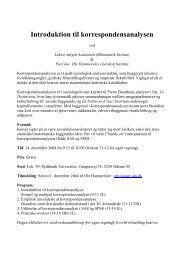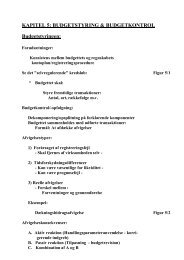the role of language skills in corporate communication
the role of language skills in corporate communication
the role of language skills in corporate communication
Create successful ePaper yourself
Turn your PDF publications into a flip-book with our unique Google optimized e-Paper software.
THE ROLE OF LANGUAGE SKILLS IN CORPORATE COMMUNICATION<br />
Paper for <strong>the</strong> Nordic Workshop on Interorganisational Research, No.12<br />
Kold<strong>in</strong>g 16. – 18. August 2002<br />
Helle Andersen<br />
(free lance <strong>in</strong>terpreter and teacher at Sou<strong>the</strong>rn Denmark University, Odense)<br />
Killerupgade 4A<br />
5220 Odense SØ<br />
6615 9482<br />
heland@<strong>language</strong>.sdu.dk<br />
Erik S. Rasmussen<br />
(lecturer)<br />
Sou<strong>the</strong>rn Denmark University, Odense<br />
Department <strong>of</strong> Market<strong>in</strong>g<br />
Campusvej 55<br />
5230 Odense M<br />
6550 3370<br />
era@sam.sdu.dk
THE ROLE OF LANGUAGE SKILLS IN CORPORATE COMMUNICATION<br />
I. The Research Sett<strong>in</strong>g<br />
Several studies <strong>in</strong> <strong>the</strong> last 20 (or more) years have focused on how <strong>in</strong>ternational firms manage <strong>the</strong>ir<br />
subsidiaries abroad, see e.g. Forsgren & Pahlberg (1992); Roth & Morrison (1992); Holm et al.<br />
(1995); Andersson (1997); Barkema & Vermeulen (1997); Barkema et al. (1997); Taggart (1997);<br />
Birk<strong>in</strong>shaw & Hood (1998); Tsang (1999); Foss & Pedersen (2002); Paterson & Brock (2002). The<br />
research has looked <strong>in</strong>to almost all aspects <strong>of</strong> <strong>the</strong> problems between headquarters and foreign subsidiaries,<br />
but one topic has – <strong>in</strong> our op<strong>in</strong>ion – not been thoroughly researched: The question <strong>of</strong> how<br />
<strong>language</strong> problems are solved. This topic can be seen <strong>in</strong> a larger research sett<strong>in</strong>g as a part <strong>of</strong> <strong>the</strong><br />
<strong>corporate</strong> <strong>in</strong>ternal – and to some extent external – <strong>communication</strong>.<br />
In this paper we will thus focus on <strong>the</strong> <strong>communication</strong> between <strong>the</strong> company and its subsidiaries<br />
abroad – and especially <strong>the</strong> importance <strong>of</strong> <strong>language</strong> <strong>skills</strong>. The object <strong>of</strong> <strong>the</strong> paper is to discuss how<br />
relations to foreign markets are handled <strong>in</strong> a communicative perspective through subsidiaries. The<br />
discussion will be based on a study <strong>of</strong> <strong>the</strong> relations between manufacturers from Funen and <strong>the</strong>ir<br />
French subsidiaries. The majority <strong>of</strong> <strong>the</strong> companies are producers <strong>of</strong> advanced mach<strong>in</strong>ery and process<strong>in</strong>g<br />
l<strong>in</strong>es. They develop, produce and sell unique products <strong>of</strong>ten <strong>in</strong> a close and necessary cooperation<br />
with <strong>the</strong> client.<br />
As mentioned, research on <strong>in</strong>ternational firms pays very little attention to <strong>the</strong> impact <strong>of</strong> <strong>language</strong> on<br />
<strong>the</strong>ir organisational structure. Though research on <strong>the</strong> concept <strong>of</strong> psychic distance <strong>in</strong> <strong>the</strong> early seventies<br />
focused on <strong>language</strong> as one <strong>of</strong> <strong>the</strong> barriers <strong>in</strong> <strong>in</strong>ternationally work<strong>in</strong>g companies' contact with<br />
foreign markets, <strong>the</strong> topic was rapidly abandoned, presumably because it was l<strong>in</strong>ked so closely to<br />
<strong>the</strong> much criticised concept <strong>of</strong> psychic distance. The literature on <strong>in</strong>ternational firms over <strong>the</strong> last 25<br />
years has focused <strong>in</strong>creas<strong>in</strong>gly on <strong>the</strong> topic <strong>of</strong> <strong>communication</strong> and cross-cultural <strong>communication</strong>.<br />
Despite this <strong>the</strong> contribution <strong>of</strong> <strong>language</strong> <strong>skills</strong> to <strong>the</strong> <strong>communication</strong> processes tak<strong>in</strong>g place <strong>in</strong>side<br />
<strong>the</strong> organisation and between <strong>the</strong> organisation and its environment has not seemed a topic at all to<br />
organisational researchers.<br />
Our search <strong>in</strong> a number <strong>of</strong> scientific databases clearly states this impression as <strong>the</strong> search for articles<br />
comb<strong>in</strong><strong>in</strong>g <strong>the</strong> key words: <strong>language</strong> - <strong>in</strong>ternational firms - <strong>communication</strong> - export as well <strong>of</strong> variations<br />
<strong>of</strong> this terms only came up with very few articles. A number <strong>of</strong> <strong>the</strong>se articles are written by<br />
consultants specialised <strong>in</strong> <strong>in</strong>ter-unit teambuild<strong>in</strong>g processes or by journalists focus<strong>in</strong>g more on <strong>the</strong><br />
development <strong>of</strong> guidel<strong>in</strong>es and problem detection for <strong>in</strong>ternationally companies The major ideas<br />
and conclusions <strong>of</strong> this articles will be presented shortly <strong>in</strong> a diachronic perspective.<br />
Very few articles are thus discuss<strong>in</strong>g <strong>the</strong> problems <strong>of</strong> <strong>language</strong> <strong>in</strong> <strong>the</strong> co-operation between a headquarter<br />
with one <strong>language</strong> and a subsidiary with ano<strong>the</strong>r <strong>language</strong>. One <strong>of</strong> <strong>the</strong> few is Marschan et<br />
al. (1997) with a title, which almost could have been used as <strong>the</strong> title <strong>of</strong> this paper: “Language, <strong>the</strong><br />
forgotten factor <strong>in</strong> mult<strong>in</strong>ational management”. As <strong>the</strong> authors states <strong>language</strong> has tended to be<br />
given <strong>in</strong> <strong>the</strong> research on mult<strong>in</strong>ational firms even though <strong>the</strong>re is an <strong>in</strong>creas<strong>in</strong>g focus on <strong>communication</strong><br />
processes and network development. The implicit solution <strong>in</strong> much research is, that <strong>language</strong><br />
standardisation has solved <strong>the</strong> problems <strong>of</strong> different <strong>language</strong>s <strong>in</strong> <strong>the</strong> subsidiaries <strong>of</strong> <strong>the</strong> mult<strong>in</strong>ational<br />
organisation. But, as <strong>the</strong> authors po<strong>in</strong>t out, <strong>language</strong> standardisation is not <strong>the</strong> same as assur<strong>in</strong>g<br />
mean<strong>in</strong>gful <strong>communication</strong>. Instead pour <strong>communication</strong> across <strong>language</strong>s is <strong>of</strong>ten one <strong>of</strong> <strong>the</strong><br />
major problems <strong>in</strong> <strong>the</strong> <strong>in</strong>tegration <strong>of</strong> subsidiaries <strong>in</strong> different countries.<br />
Side 2 af 16 - 05-08-02
THE ROLE OF LANGUAGE SKILLS IN CORPORATE COMMUNICATION<br />
The development <strong>in</strong> <strong>the</strong> mult<strong>in</strong>ational firms towards flatter structures and horizontal co-operation<br />
and <strong>communication</strong> to ensure <strong>the</strong> <strong>in</strong>tegration <strong>of</strong> all parts <strong>of</strong> <strong>the</strong> firm 1 makes <strong>the</strong> dependency <strong>of</strong> a<br />
common <strong>language</strong> even stronger. The horizontal <strong>communication</strong> depends almost always on a network<br />
<strong>of</strong> personal relationships, which are <strong>language</strong> dependent. This <strong>in</strong>formal <strong>in</strong>formation flow is<br />
<strong>the</strong> basis for an effective horizontal <strong>communication</strong>, but <strong>the</strong> issue <strong>of</strong> <strong>language</strong> <strong>skills</strong> – which are<br />
extremely important – is ignored <strong>in</strong> almost all literature on <strong>in</strong>formal <strong>communication</strong>, as Marschan et<br />
al. (1997) po<strong>in</strong>ts out.<br />
The ma<strong>in</strong> question for Marschan et al. (1997) is thus: “how do staff who are only fluent <strong>in</strong> <strong>the</strong>ir<br />
mo<strong>the</strong>r tongue, which is not <strong>the</strong> selected company <strong>language</strong>, operate across <strong>the</strong> organisation’s<br />
functional and national boundaries?”(p.593). This question is especially important when we look<br />
at firms from small <strong>language</strong> groups like F<strong>in</strong>land or Denmark.<br />
Marschan et al. (1997) found different k<strong>in</strong>ds <strong>of</strong> solutions to <strong>the</strong>se problems. First <strong>of</strong> all <strong>the</strong>re is <strong>the</strong><br />
passive behaviour where problems <strong>of</strong> <strong>language</strong> are ignored or disregarded. This typically means that<br />
<strong>communication</strong> is not read or heard and effective <strong>communication</strong> is thus prevented by <strong>the</strong> lack <strong>of</strong><br />
<strong>language</strong> fluency. Ano<strong>the</strong>r solution is <strong>the</strong> use <strong>of</strong> <strong>language</strong> <strong>in</strong>termediaries with<strong>in</strong> <strong>the</strong> subsidiary or at<br />
<strong>the</strong> mo<strong>the</strong>r company. Very <strong>of</strong>ten an expatriate – or ano<strong>the</strong>r person with a good knowledge <strong>of</strong> <strong>the</strong><br />
‘<strong>of</strong>ficial <strong>language</strong>’ – is approached to translate and becomes a ‘<strong>language</strong> node’ <strong>in</strong> <strong>the</strong> <strong>communication</strong>.<br />
The person who is ‘<strong>language</strong> node’ has <strong>of</strong>ten not an <strong>of</strong>ficial position <strong>in</strong> <strong>the</strong> <strong>communication</strong><br />
network but is taken away from his or her <strong>of</strong>ficial work to translate. Still ano<strong>the</strong>r solution is to build<br />
up <strong>in</strong>formal networks <strong>of</strong> match<strong>in</strong>g <strong>language</strong> <strong>skills</strong> outside <strong>the</strong> subsidiary – at o<strong>the</strong>r subsidiaries and<br />
<strong>in</strong> <strong>the</strong> headquarters. Marschan et al. (1997) mentions an example with a Spanish subsidiary <strong>of</strong> <strong>the</strong><br />
F<strong>in</strong>nish firm Kone where <strong>the</strong> managers made a list <strong>of</strong> Spanish speak<strong>in</strong>g persons from <strong>the</strong> Kone telephone<br />
directory. These persons made up a small but very efficient personal network at <strong>the</strong> headquarter<br />
and at o<strong>the</strong>r subsidiaries.<br />
None <strong>of</strong> <strong>the</strong> mentioned solutions are especially efficient or useful <strong>in</strong> <strong>the</strong> long run. Instead a solution<br />
could be that all employees learn <strong>the</strong> <strong>of</strong>ficial company <strong>language</strong> (<strong>in</strong> most cases, this means English).<br />
Only recruit<strong>in</strong>g English speak<strong>in</strong>g personnel can also do this. This solution looks quite simple, but<br />
<strong>the</strong>re is a tendency to forget that <strong>the</strong> major task <strong>of</strong> <strong>the</strong> subsidiary is to be locally responsive – to be<br />
<strong>in</strong> contact with customers, stakeholders, and o<strong>the</strong>rs <strong>in</strong> <strong>the</strong>re local <strong>language</strong>. Therefore Marschan et<br />
al. (1997) states: “Be<strong>in</strong>g locally responsive <strong>in</strong> <strong>the</strong> <strong>language</strong> context is also a requirement for effective<br />
<strong>communication</strong> with external stakeholders at <strong>the</strong> subsidiary level. The standardisation <strong>of</strong> <strong>language</strong><br />
is fraught with similar difficulties to those associated with market<strong>in</strong>g and o<strong>the</strong>r global activities”<br />
(p.595).<br />
Two years later Marschan et al. (1997) was followed by ano<strong>the</strong>r paper by <strong>the</strong> same authors and with<br />
<strong>the</strong> F<strong>in</strong>nish firm Kone as <strong>the</strong> empirical ground. This paper Marschan-Piekkari et al. (1999) is<br />
though more focused on <strong>the</strong> impact <strong>of</strong> <strong>language</strong> on structure, power and <strong>communication</strong> <strong>in</strong> a mult<strong>in</strong>ational<br />
firm. One <strong>of</strong> <strong>the</strong> major conclusions seen from our po<strong>in</strong>t <strong>of</strong> view is, that staff with superior<br />
<strong>language</strong> capabilities is able to build strong personal networks with<strong>in</strong> <strong>the</strong> mult<strong>in</strong>ational firm. Language<br />
becomes <strong>in</strong> this way an <strong>in</strong>formal source <strong>of</strong> expert power <strong>in</strong> <strong>the</strong> co-operation between a mult<strong>in</strong>ational<br />
firm and its subsidiary abroad.<br />
1 See e.g. Hedlund (1986); Bartlett & Ghoshal (1989)<br />
Side 3 af 16 - 05-08-02
THE ROLE OF LANGUAGE SKILLS IN CORPORATE COMMUNICATION<br />
The ma<strong>in</strong> purpose <strong>of</strong> Marschan-Piekkari et al. (1999) is to explore <strong>the</strong> impact <strong>of</strong> <strong>language</strong> on <strong>communication</strong><br />
with<strong>in</strong> large and geographical dispersed mult<strong>in</strong>ationals. The paper is based on an <strong>in</strong>depth<br />
exploratory case study <strong>of</strong> <strong>the</strong> F<strong>in</strong>nish mult<strong>in</strong>ational company Kone and its subsidiaries. The<br />
research context is that <strong>of</strong> organisational changes <strong>in</strong> mult<strong>in</strong>ationals from hierarchical structures to<br />
less hierarchical and more horizontal structures. Previous research on this topic suggests that this<br />
shift <strong>in</strong> <strong>the</strong> mult<strong>in</strong>ationals is accompanied by an <strong>in</strong>creased focus on flexible <strong>in</strong>ter-unit <strong>communication</strong><br />
and team-build<strong>in</strong>g processes as a means to assure <strong>in</strong>formal control mechanisms and to create<br />
networks <strong>of</strong> personal relationships. The personal networks are seen as vital to <strong>the</strong> transmission <strong>of</strong><br />
expertise from one unit to ano<strong>the</strong>r with<strong>in</strong> <strong>the</strong> organisation. However to Marschan-Piekkari, Welch<br />
and Welch both mult<strong>in</strong>ationals and researchers have neglected <strong>the</strong> <strong>role</strong> played by <strong>language</strong> as a potential<br />
barrier to <strong>the</strong> <strong>in</strong>ter-unit <strong>communication</strong>. On this background, <strong>the</strong>y set out to explore <strong>the</strong> <strong>role</strong><br />
<strong>of</strong> <strong>language</strong> <strong>in</strong> <strong>the</strong> MNC <strong>in</strong>ter-unit <strong>communication</strong> and its effect <strong>in</strong> terms <strong>of</strong>:<br />
1) Control and co-ord<strong>in</strong>ation processes and procedures<br />
2) Language as a source <strong>of</strong> power<br />
3) Language and organisational structure<br />
The <strong>communication</strong> structure is studied not only <strong>in</strong> a traditional subsidiary - headquarter perspective<br />
but also <strong>in</strong>cludes <strong>the</strong> <strong>in</strong>ter-subsidiary relationships, as <strong>the</strong>se seem to ga<strong>in</strong> importance.<br />
The case study was conducted as a series <strong>of</strong> 110 <strong>in</strong>terviews with employees selected from three organisational<br />
levels: top management; middle management and operational level. The <strong>in</strong>terviewees<br />
represented 25 units based <strong>in</strong> non-English speak<strong>in</strong>g countries, English be<strong>in</strong>g <strong>the</strong> company <strong>language</strong>.<br />
The 25 units were each selected accord<strong>in</strong>g to variations <strong>in</strong> geographical location, size, economic<br />
importance, year <strong>of</strong> acquisition, and cultural background. 65% <strong>of</strong> <strong>the</strong> <strong>in</strong>terviewees mentioned <strong>language</strong><br />
as a factor <strong>in</strong> <strong>the</strong> <strong>communication</strong> with o<strong>the</strong>r units <strong>in</strong> Kone. The attitudes to <strong>the</strong> <strong>role</strong> <strong>of</strong> <strong>language</strong><br />
<strong>in</strong> <strong>the</strong> <strong>communication</strong> process tak<strong>in</strong>g place <strong>in</strong>side <strong>the</strong> Kone organisation are studied from<br />
three perspectives:<br />
1) Language as a barrier<br />
2) Language as a facilitator<br />
3) Language as a source <strong>of</strong> power<br />
Language as a barrier is a well-known phenomenon to cross-cultural <strong>communication</strong> research and<br />
<strong>the</strong> Kone case showed an evident problem <strong>in</strong> two fields. 1) With<strong>in</strong> <strong>the</strong> immediate field <strong>of</strong> <strong>communication</strong><br />
- distorted <strong>communication</strong>, <strong>communication</strong> that was delayed or not transmitted at all -<br />
operation manuals written <strong>in</strong> English and impossible to read for <strong>the</strong> Spanish speak<strong>in</strong>g personal.<br />
2) With<strong>in</strong> <strong>the</strong> field <strong>of</strong> establish<strong>in</strong>g networks - limited <strong>skills</strong> <strong>in</strong> English made it impossible to many<br />
middle managers and employees at operational level to jo<strong>in</strong> tra<strong>in</strong><strong>in</strong>g programmes organised by<br />
Kone. It was thus impossible to create personal ties to employees <strong>in</strong> o<strong>the</strong>r units open<strong>in</strong>g up for possibilities<br />
to seek advice, access critical <strong>in</strong>formation earlier, and to speed up <strong>the</strong> decision-mak<strong>in</strong>g<br />
process at subsidiary level. A group <strong>of</strong> largely Spanish speak<strong>in</strong>g personal was isolated with<strong>in</strong> <strong>the</strong><br />
company not be<strong>in</strong>g considered candidates to tra<strong>in</strong><strong>in</strong>g programmes.<br />
The cop<strong>in</strong>g strategies developed by <strong>the</strong> subsidiaries to overcome <strong>the</strong> <strong>language</strong> barrier are those <strong>of</strong><br />
<strong>in</strong>ternal (unauthorised) translation <strong>of</strong> company documentation, <strong>the</strong> use <strong>of</strong> <strong>in</strong>termediaries with <strong>skills</strong><br />
<strong>in</strong> <strong>the</strong> company <strong>language</strong> or <strong>in</strong> F<strong>in</strong>nish, <strong>the</strong> top management be<strong>in</strong>g largely F<strong>in</strong>nish speak<strong>in</strong>g.<br />
Side 4 af 16 - 05-08-02
THE ROLE OF LANGUAGE SKILLS IN CORPORATE COMMUNICATION<br />
As well as lack <strong>of</strong> <strong>language</strong> <strong>skills</strong> can be seen to have very negative consequences to an employee's<br />
possibilities to access <strong>the</strong> <strong>communication</strong> networks, <strong>the</strong> possession <strong>of</strong> <strong>the</strong> relevant <strong>language</strong> <strong>skills</strong><br />
can facilitate <strong>the</strong> <strong>in</strong>ter-unit <strong>communication</strong> flows. The Kone data show that persons with good <strong>skills</strong><br />
<strong>in</strong> English (and F<strong>in</strong>nish) who are able to play <strong>the</strong> <strong>role</strong> <strong>of</strong> <strong>language</strong> <strong>in</strong>termediary / translator can obta<strong>in</strong><br />
a higher status <strong>in</strong> <strong>the</strong> organisation than <strong>the</strong>ir functional position would normally justify.<br />
At subsidiary level, a regional co-operation was established <strong>in</strong> several cases on <strong>the</strong> basis <strong>of</strong> a shared<br />
<strong>language</strong> o<strong>the</strong>r than English. This was <strong>the</strong> case <strong>of</strong> a German - Austrian co-operation and that <strong>of</strong> a<br />
Spanish - Italian co-operation which were established <strong>in</strong> order to <strong>of</strong>fer jo<strong>in</strong>t tra<strong>in</strong><strong>in</strong>g courses. In one<br />
case, Spanish managers went to visit o<strong>the</strong>r subsidiaries <strong>in</strong> order to establish personal relations to<br />
Spanish speak<strong>in</strong>g employees, which could function as an alternative <strong>communication</strong> network. These<br />
are ways <strong>in</strong> which <strong>language</strong> is used <strong>in</strong> a conscious way to facilitate <strong>the</strong> shar<strong>in</strong>g <strong>of</strong> advice, <strong>in</strong>formation,<br />
and knowledge.<br />
Language as a source <strong>of</strong> power: Kone has <strong>in</strong>troduced English as <strong>the</strong> (only) company <strong>language</strong> and<br />
company <strong>communication</strong> like <strong>the</strong> annual report is only published <strong>in</strong> English but <strong>the</strong> analysis <strong>of</strong> <strong>the</strong><br />
Kone data show that <strong>language</strong> imposes its own structure on <strong>communication</strong> networks. Inter-unit<br />
<strong>communication</strong> appeared to a high degree to be person-bound and <strong>the</strong> <strong>communication</strong> <strong>in</strong> <strong>the</strong>se networks<br />
was channelled through employees who were particularly capable <strong>of</strong> speak<strong>in</strong>g <strong>the</strong> relevant<br />
foreign <strong>language</strong>. In this way employees <strong>in</strong> <strong>the</strong> Kone subsidiaries could ga<strong>in</strong> more <strong>in</strong>fluence than<br />
<strong>the</strong>ir position <strong>in</strong> <strong>the</strong> organisation would normally allow.<br />
The analysis has shown that <strong>the</strong> use <strong>of</strong> <strong>language</strong> <strong>in</strong>fluences <strong>the</strong> <strong>communication</strong> networks with<strong>in</strong><br />
Kone. The <strong>in</strong>troduction <strong>of</strong> English as company <strong>language</strong> has not elim<strong>in</strong>ated this problem and underly<strong>in</strong>g<br />
<strong>the</strong> formal organisational structure <strong>the</strong> use <strong>of</strong> foreign <strong>language</strong>s created a shadow structure<br />
based on shared <strong>language</strong>s o<strong>the</strong>r than English and <strong>language</strong> mediators / nodes. This shadow structure<br />
based on <strong>language</strong> seemed to be an important aspect <strong>of</strong> <strong>the</strong> subsidiary's power base.<br />
One <strong>of</strong> <strong>the</strong> o<strong>the</strong>r articles focuss<strong>in</strong>g on <strong>language</strong> <strong>in</strong> <strong>the</strong> <strong>in</strong>ternationalisation <strong>of</strong> <strong>the</strong> firm is Crick<br />
(1999). This article <strong>in</strong>vestigates <strong>the</strong> use <strong>of</strong> <strong>language</strong> with<strong>in</strong> UK small and medium-sized firms with<br />
export. The result from a large survey po<strong>in</strong>ts to <strong>the</strong> conclusion that most firms are aware <strong>of</strong> <strong>the</strong> importance<br />
<strong>of</strong> <strong>language</strong>s but this is not reflected <strong>in</strong> <strong>the</strong>ir daily work and not with<strong>in</strong> <strong>the</strong> recruitment and<br />
tra<strong>in</strong><strong>in</strong>g <strong>of</strong> personnel. Seen from our po<strong>in</strong>t <strong>of</strong> view especially <strong>the</strong> documentation <strong>of</strong> <strong>communication</strong><br />
problems <strong>in</strong> English speak<strong>in</strong>g firms is <strong>in</strong>terest<strong>in</strong>g.<br />
The research topic is placed <strong>in</strong> a cross-cultural perspective, <strong>the</strong> use <strong>of</strong> foreign <strong>language</strong>s be<strong>in</strong>g one<br />
<strong>of</strong> <strong>the</strong> most salient elements <strong>of</strong> <strong>the</strong> <strong>communication</strong> <strong>of</strong> <strong>in</strong>ternationally work<strong>in</strong>g firms. The immediate<br />
research context is set by two studies referred to by Crick report<strong>in</strong>g:<br />
1) That approximately 33% <strong>of</strong> English companies experience <strong>language</strong> problems <strong>in</strong><br />
<strong>the</strong>ir contact with foreign markets<br />
2) That UK companies <strong>in</strong> general are los<strong>in</strong>g valuable trad<strong>in</strong>g opportunities because<br />
<strong>the</strong>y lack <strong>language</strong> <strong>skills</strong> <strong>in</strong> certa<strong>in</strong> <strong>language</strong>s<br />
Related to <strong>the</strong> ma<strong>in</strong> topic <strong>of</strong> managers' perceived importance and benefits <strong>of</strong> us<strong>in</strong>g foreign <strong>language</strong>s<br />
<strong>in</strong> <strong>the</strong>ir export operations, Dave Crick studies a number <strong>of</strong> related <strong>the</strong>mes which are:<br />
Side 5 af 16 - 05-08-02
THE ROLE OF LANGUAGE SKILLS IN CORPORATE COMMUNICATION<br />
1) Issues prevent<strong>in</strong>g <strong>the</strong>ir use<br />
2) The functional use <strong>of</strong> <strong>language</strong>s with<strong>in</strong> bus<strong>in</strong>esses and<br />
3) The firms' recruitment and tra<strong>in</strong><strong>in</strong>g policies <strong>in</strong> respect to <strong>language</strong>s.<br />
Crick divides <strong>the</strong> firms <strong>in</strong> 4 groups accord<strong>in</strong>g to <strong>the</strong>ir size, but all 4 groups <strong>of</strong> managers show <strong>the</strong><br />
same attitude towards <strong>the</strong> use <strong>of</strong> foreign <strong>language</strong>s. All <strong>of</strong> <strong>the</strong>m see <strong>the</strong> use <strong>of</strong> foreign <strong>language</strong>s as<br />
important to <strong>the</strong>ir firms' operations and for <strong>the</strong> same two reasons. The use <strong>of</strong> foreign <strong>language</strong>s enhances<br />
image and <strong>in</strong>crease orders. The managers also agree on <strong>the</strong> reason for <strong>the</strong> benefits <strong>of</strong> foreign<br />
<strong>language</strong> <strong>skills</strong>. It signals a will<strong>in</strong>gness to come forward to meet <strong>the</strong> clients and is thus closely related<br />
to <strong>the</strong> image aspect and <strong>the</strong> relational field. A significant difference <strong>in</strong> attitude can be noticed<br />
though when it comes to <strong>the</strong> issue <strong>of</strong> why <strong>language</strong>s are not put to use <strong>in</strong> <strong>the</strong> firm. To firms with<br />
less than a hundred employees <strong>the</strong> arguments <strong>of</strong> English as a widely spoken <strong>language</strong>, lack <strong>of</strong> relevant<br />
<strong>skills</strong>, time and cost <strong>in</strong>volved are given a high priority whereas companies with more than a<br />
hundred employees see <strong>the</strong>se aspects as less important.<br />
With<strong>in</strong> <strong>the</strong> doma<strong>in</strong> <strong>of</strong> recruitment and tra<strong>in</strong><strong>in</strong>g policies all four groups <strong>of</strong> firms show identical behaviour.<br />
One half <strong>of</strong> <strong>the</strong> firms confirm to look for people with <strong>language</strong> <strong>skills</strong> when <strong>the</strong>y are recruit<strong>in</strong>g<br />
new employees whereas <strong>the</strong> o<strong>the</strong>r half doesn't look for this particular competence <strong>in</strong> <strong>the</strong> recruit<strong>in</strong>g<br />
process. In general <strong>the</strong> firms don't provide any <strong>language</strong> tra<strong>in</strong><strong>in</strong>g for <strong>the</strong>ir employees, nei<strong>the</strong>r do<br />
<strong>the</strong>y try to encourage <strong>the</strong> employees to take up <strong>language</strong> tra<strong>in</strong><strong>in</strong>g. On <strong>the</strong> contrary, <strong>the</strong> companies<br />
seem to rely on <strong>the</strong> employees' exist<strong>in</strong>g <strong>language</strong> <strong>skills</strong>.<br />
Cricks f<strong>in</strong>d<strong>in</strong>gs correspond with our observations <strong>in</strong> <strong>the</strong> field <strong>of</strong> recruitment and tra<strong>in</strong><strong>in</strong>g policies for<br />
<strong>the</strong> Danish firms and <strong>the</strong> paper fur<strong>the</strong>rmore is a contribution to <strong>the</strong> discussion on <strong>the</strong> <strong>in</strong>troduction <strong>of</strong><br />
English as company <strong>language</strong> <strong>in</strong> many <strong>in</strong>ternationally work<strong>in</strong>g companies as a strategy to overcome<br />
<strong>the</strong> <strong>language</strong> barrier.<br />
Mel Berger, see Berger (1998), works as a consultant <strong>in</strong> team build<strong>in</strong>g processes and <strong>in</strong> his article<br />
he identifies <strong>the</strong> cross cultural <strong>skills</strong> that are essential for <strong>the</strong> <strong>communication</strong> with o<strong>the</strong>rs for whom<br />
English is not <strong>the</strong>ir first <strong>language</strong>. The article presents a short case about a teambuild<strong>in</strong>g tra<strong>in</strong><strong>in</strong>g<br />
session <strong>in</strong> an English-French Company. Berger presents some guidel<strong>in</strong>es how to evaluate a person’s<br />
communicative skill. To Berger communicative <strong>skills</strong> mean to be able to understand <strong>the</strong> listener’s<br />
situation and to adapt ones speech to <strong>the</strong> listener’s level <strong>of</strong> understand<strong>in</strong>g. Communicative <strong>skills</strong> are<br />
based on four competencies:<br />
1) Gaug<strong>in</strong>g one's level <strong>of</strong> jargon and speed <strong>of</strong> delivery to <strong>the</strong> <strong>language</strong> fluency <strong>of</strong> <strong>the</strong><br />
listener<br />
2) Recognis<strong>in</strong>g <strong>the</strong> differ<strong>in</strong>g mean<strong>in</strong>gs <strong>of</strong> verbal and non-verbal behaviour<br />
3) Listen<strong>in</strong>g and question<strong>in</strong>g to understand <strong>the</strong> views and op<strong>in</strong>ions <strong>of</strong> o<strong>the</strong>rs<br />
4) Awareness <strong>of</strong> what is expected at <strong>the</strong> <strong>in</strong>itial stage <strong>of</strong> build<strong>in</strong>g a relationship <strong>in</strong> order<br />
to build sufficient trust to work toge<strong>the</strong>r productively.<br />
The case example showed that <strong>the</strong> English employees were hard to understand for <strong>the</strong>ir French colleagues<br />
because <strong>of</strong> <strong>the</strong>ir speed <strong>of</strong> talk<strong>in</strong>g and <strong>the</strong>ir extensive use <strong>of</strong> jargon. The French employees<br />
were contrarily seen as irrational and lack<strong>in</strong>g credibility because <strong>of</strong> <strong>the</strong>ir enthusiastic <strong>communication</strong><br />
style and <strong>the</strong>ir emotional approach to discussions.<br />
Side 6 af 16 - 05-08-02
THE ROLE OF LANGUAGE SKILLS IN CORPORATE COMMUNICATION<br />
The consultant William Oncken III, see Oncken III (1998), works along <strong>the</strong> same l<strong>in</strong>e although he<br />
is deal<strong>in</strong>g with different registers with<strong>in</strong> <strong>the</strong> same <strong>language</strong>, not with different <strong>language</strong>s. He <strong>of</strong>fers<br />
a def<strong>in</strong>ition <strong>of</strong> <strong>communication</strong> that we will refer to <strong>in</strong> our paper. To Oncken III: Communication is<br />
<strong>the</strong> cha<strong>in</strong> <strong>of</strong> understand<strong>in</strong>g that <strong>in</strong>tegrates an organization form top to bottom, form bottom to top,<br />
and from side to side…Cha<strong>in</strong>s <strong>of</strong> understand<strong>in</strong>g are not easy to design or to ma<strong>in</strong>ta<strong>in</strong>.<br />
Freelance writer Jean Cumm<strong>in</strong>g, see Cumm<strong>in</strong>g (1998), deals <strong>in</strong> her article with <strong>the</strong> strategies Canadian<br />
bankers put <strong>in</strong>to use <strong>in</strong> order to adapt <strong>the</strong>ir services to a multiethnic, multicultural and multil<strong>in</strong>guistic<br />
society. In opposition to <strong>the</strong> o<strong>the</strong>r articles Cumm<strong>in</strong>g deals with companies which face<br />
multi-l<strong>in</strong>guicity on <strong>the</strong>ir immediate home market. Accord<strong>in</strong>g to <strong>the</strong> author, most Canadian banks<br />
have a positive cultural response to <strong>the</strong> multiethnic character <strong>of</strong> <strong>the</strong> <strong>the</strong>ir markets, expressed e.g. by<br />
<strong>the</strong> celebration <strong>of</strong> "ethnic" holidays. The l<strong>in</strong>guistic element <strong>in</strong> this celebration is quite obvious, for<br />
example greet<strong>in</strong>gs and wishes <strong>in</strong> Tagalog, Gwich'<strong>in</strong>, Mandar<strong>in</strong> etc. Employees are taught to say<br />
simple greet<strong>in</strong>gs <strong>in</strong> <strong>the</strong> <strong>language</strong> <strong>of</strong> <strong>the</strong>ir clients as well as pr<strong>in</strong>ted materials are available <strong>in</strong> <strong>the</strong>ir<br />
mo<strong>the</strong>r tongue. The telephone bank<strong>in</strong>g services have put a very conscious effort <strong>in</strong>to <strong>the</strong> recruit<strong>in</strong>g<br />
<strong>of</strong> bil<strong>in</strong>gual personal. To a certa<strong>in</strong> extend traditions from <strong>the</strong> clients' cultural background are <strong>in</strong>tegrated<br />
<strong>in</strong> <strong>the</strong> services <strong>of</strong> <strong>the</strong> banks, for <strong>in</strong>stance <strong>in</strong> relation to gift giv<strong>in</strong>g traditions. The benefits <strong>of</strong><br />
this multi-l<strong>in</strong>guistic pr<strong>of</strong>ile are difficult to estimate but <strong>the</strong> bank managers consider it a strength <strong>in</strong><br />
respect to image. One bank manager is reported to say that <strong>the</strong>reby <strong>the</strong>y ga<strong>in</strong> valuable experience <strong>in</strong><br />
cross-cultural <strong>communication</strong>, which can be brought <strong>in</strong>to use when it comes to operations on foreign<br />
markets.<br />
If we take a look at <strong>language</strong> problems and <strong>language</strong> <strong>skills</strong> <strong>in</strong> <strong>the</strong> broader context <strong>of</strong> <strong>the</strong> <strong>in</strong>ternationalisation<br />
<strong>of</strong> firms it is <strong>in</strong>terest<strong>in</strong>g to see a parallel to <strong>the</strong> concept psychic distance, see e.g. Vahlne &<br />
Wiedersheim Paul (1973); Sullivan & Bauerschmidt (1990); Kle<strong>in</strong> & Roth (1990); Nordstrom &<br />
Vahlne (1994); O'Grady & Lane (1996). The idea that <strong>the</strong> distance between a firm’s home country<br />
and a potential export country not should be measured <strong>in</strong> kilometres or miles but as a psychic distance<br />
<strong>in</strong>volves measures <strong>of</strong> cultural distance but also <strong>language</strong> distance. The concept <strong>of</strong> psychic<br />
distance was heavily criticised – see e.g. Cz<strong>in</strong>kota & Ursic (1987); Sullivan & Bauerschmidt<br />
(1990); Nordstrom & Vahlne (1994); O'Grady & Lane (1996); Stött<strong>in</strong>ger & Schlegelmilch (1998) –<br />
and almost disappeared from <strong>the</strong> <strong>in</strong>ternationalisation <strong>of</strong> <strong>the</strong> firm literature. One <strong>of</strong> <strong>the</strong> reasons for<br />
overlook<strong>in</strong>g <strong>the</strong> <strong>language</strong> problems <strong>in</strong> <strong>the</strong> <strong>in</strong>ternalisation literature is maybe that <strong>language</strong> has been<br />
closely connected to psychic distance.<br />
II. Methodology and data<br />
The empirical data for <strong>the</strong> paper stems from exploratory research amongst Danish firms with subsidiaries<br />
<strong>in</strong> France. Through a database <strong>of</strong> Danish firms (CD-Direct) 30 firms with subsidiaries <strong>in</strong><br />
France were identified. All <strong>the</strong>se firms are placed on <strong>the</strong> island <strong>of</strong> Funen, which has app. 15% <strong>of</strong> all<br />
Danish firms. The firms were contacted by telephone to identify <strong>the</strong> person responsible for <strong>the</strong><br />
<strong>communication</strong> with France. A questionnaire with several open-ended questions was send by mail<br />
to this person. 15 usable questionnaires were returned toge<strong>the</strong>r with several e-mails with comments<br />
and telephone conversation with several respondents.<br />
The larger research sett<strong>in</strong>g is a project, which aims at look<strong>in</strong>g at all types <strong>of</strong> bus<strong>in</strong>ess contacts with<br />
French speak<strong>in</strong>g markets. Four types <strong>of</strong> relations to <strong>the</strong> markets have been identified toge<strong>the</strong>r with<br />
<strong>the</strong> <strong>communication</strong> typically used <strong>in</strong> each relation.<br />
Side 7 af 16 - 05-08-02
THE ROLE OF LANGUAGE SKILLS IN CORPORATE COMMUNICATION<br />
Figure 1: Typology <strong>of</strong> firms with relations to <strong>the</strong> French speak<strong>in</strong>g markets<br />
Type <strong>of</strong> relation Communication<br />
1. Firms with sparse contacts to France Communication <strong>in</strong> English<br />
– economically <strong>in</strong>significant<br />
No plan for us<strong>in</strong>g French speak<strong>in</strong>g resources <strong>in</strong> <strong>the</strong> firm<br />
2. Firms with periodically large cus- Systematic search for customers<br />
tomers <strong>in</strong> France. The <strong>in</strong>dividual order Communication <strong>in</strong> English<br />
is economically significant for <strong>the</strong> firm External help is used for special purposes – translation <strong>of</strong><br />
technical matters, etc.<br />
3. Firms with <strong>in</strong>tensive contact with Systematic use <strong>of</strong> l<strong>in</strong>guistic competencies <strong>in</strong> <strong>the</strong> firm<br />
different k<strong>in</strong>d <strong>of</strong> customers <strong>in</strong> France Communication <strong>in</strong> French<br />
External help is perhaps used for specialised purposes –<br />
translation <strong>of</strong> technical matters, etc.<br />
4. Firms with <strong>in</strong>tensive contact with Communication with <strong>the</strong> market is almost <strong>the</strong> subsidiaries<br />
different k<strong>in</strong>d <strong>of</strong> customers <strong>in</strong> France responsibility<br />
systematised by <strong>the</strong> use <strong>of</strong> subsidiaries The employees at <strong>the</strong> subsidiary are almost all French<br />
<strong>in</strong> France<br />
Communication between <strong>the</strong> headquarter and <strong>the</strong> subsidiary<br />
is <strong>in</strong> English<br />
The formal French l<strong>in</strong>guistic competence at <strong>the</strong> headquarter<br />
is only used for quite simple rout<strong>in</strong>e tasks<br />
Often native speakers <strong>in</strong> <strong>the</strong> headquarter are used as ‘<strong>language</strong><br />
nodes’<br />
The data for this article comes merely from firms from group four – Danish firms with subsidiaries<br />
<strong>in</strong> France. It is <strong>in</strong>terest<strong>in</strong>g to see <strong>the</strong> major difference regard<strong>in</strong>g <strong>the</strong> use <strong>of</strong> l<strong>in</strong>guistic competence<br />
between firms from group three and four. Both types <strong>of</strong> firms have <strong>in</strong>tensive and long-last<strong>in</strong>g relations<br />
with customers and suppliers <strong>in</strong> France, but <strong>the</strong> firms from group four operate <strong>in</strong> arms-length<br />
through <strong>the</strong> use <strong>of</strong> one or more subsidiaries. The l<strong>in</strong>guistic competence is thus merely developed<br />
and extended <strong>in</strong> firms from group three.<br />
As mentioned <strong>the</strong> questionnaires consisted primarily <strong>of</strong> questions with open-ended answers plus a<br />
few questions regard<strong>in</strong>g <strong>the</strong> firm – number <strong>of</strong> employees, type <strong>of</strong> products, etc. The respondents<br />
were <strong>the</strong> one responsible for <strong>the</strong> <strong>communication</strong> with France and typically it was a person with<br />
some k<strong>in</strong>d <strong>of</strong> formal education <strong>in</strong> French. The respondents were <strong>of</strong>ten very frustrated by <strong>the</strong> lack <strong>of</strong><br />
pr<strong>of</strong>essional <strong>communication</strong> <strong>in</strong> <strong>the</strong>ir firms. Often a lot <strong>of</strong> <strong>the</strong> core <strong>communication</strong> was given to a<br />
person with a background <strong>in</strong> French – e.g. an eng<strong>in</strong>eer from France – who did not have <strong>the</strong> formal<br />
education to translate between French and Danish. This frustration gave long answers from many <strong>of</strong><br />
<strong>the</strong> respondents – <strong>in</strong>dicat<strong>in</strong>g that an emotional and important question was touched.<br />
All <strong>the</strong> correspondence with <strong>the</strong> respondents (questionnaire, email, telephone conversation, etc.)<br />
<strong>in</strong>dicated, that <strong>the</strong> <strong>communication</strong> to French customers was separated <strong>in</strong> two sharply divided circuits<br />
– <strong>the</strong> <strong>communication</strong> between <strong>the</strong> mo<strong>the</strong>r company and <strong>the</strong> subsidiary and <strong>the</strong> <strong>communication</strong><br />
between <strong>the</strong> subsidiary <strong>in</strong> France and <strong>the</strong> customers. To that could be added a third circuit – <strong>the</strong><br />
<strong>communication</strong> between <strong>the</strong> customers <strong>in</strong> France and <strong>the</strong> mo<strong>the</strong>r company <strong>in</strong> Denmark. The contact<br />
to <strong>the</strong> French employees <strong>in</strong> <strong>the</strong> subsidiary is extremely sparse and typically only one person at <strong>the</strong><br />
subsidiary has any contact with Denmark. The employees at <strong>the</strong> French subsidiary are, for example,<br />
not <strong>in</strong>vited to visit <strong>the</strong> firm <strong>in</strong> Denmark. This means that <strong>the</strong> firm will not get very valuable <strong>in</strong>formation<br />
regard<strong>in</strong>g, for example, <strong>the</strong> culture, <strong>the</strong> customers, reactions to new products, ideas, etc.<br />
Side 8 af 16 - 05-08-02
III. Def<strong>in</strong>itions<br />
THE ROLE OF LANGUAGE SKILLS IN CORPORATE COMMUNICATION<br />
By ’<strong>corporate</strong> <strong>communication</strong>’ we understand <strong>the</strong> <strong>communication</strong>, which takes place <strong>in</strong>side <strong>the</strong><br />
company – <strong>in</strong>side divisions, between divisions, between headquarter and subsidiary – and between<br />
<strong>the</strong> company and its environment, for example customers. We will primarily focus on <strong>the</strong> <strong>in</strong>ternal<br />
<strong>communication</strong> between <strong>the</strong> Danish headquarter and <strong>the</strong> French subsidiaries. The <strong>corporate</strong> <strong>communication</strong><br />
will be discussed <strong>in</strong> relation to two key concepts:<br />
• Core <strong>communication</strong><br />
• Functional <strong>communication</strong><br />
‘Core <strong>communication</strong>’ is a parallel to <strong>the</strong> concept <strong>of</strong> ‘core competence’ and covers <strong>the</strong> communicative<br />
activities, which are vital to <strong>the</strong> development <strong>of</strong> <strong>the</strong> firm. This <strong>in</strong>novative activity takes place <strong>in</strong><br />
a close co-operation between <strong>the</strong> client and employees placed <strong>in</strong> <strong>the</strong> firm’s headquarter. Core <strong>communication</strong><br />
is thus <strong>in</strong>tended to establish and ma<strong>in</strong>ta<strong>in</strong> <strong>the</strong> relationships <strong>in</strong> which <strong>the</strong> <strong>in</strong>dividual solutions<br />
are designed.<br />
By ‘functional <strong>communication</strong>’ we understand a set <strong>of</strong> communicative standard rout<strong>in</strong>es – e.g.<br />
traditional bus<strong>in</strong>ess letters and technical documentation. The ‘functional <strong>communication</strong>’ covers <strong>the</strong><br />
implementation <strong>of</strong> <strong>the</strong> agreement that <strong>the</strong> parties engaged <strong>in</strong> <strong>the</strong> <strong>in</strong>novative process have reached<br />
and on <strong>the</strong> relational level it establishes a two-part relationship distribut<strong>in</strong>g obligations and responsibility.<br />
As mentioned it is <strong>of</strong>ten postulated that <strong>the</strong> general <strong>language</strong> <strong>skills</strong> are improv<strong>in</strong>g (read <strong>the</strong> ability to<br />
use English amongst non native speakers are spread<strong>in</strong>g rapidly), but we mean that is necessary to<br />
dist<strong>in</strong>guish between <strong>language</strong> <strong>skills</strong> and <strong>communication</strong> <strong>skills</strong>. A manager from <strong>the</strong> UK is <strong>of</strong> course<br />
very skilled <strong>in</strong> speak<strong>in</strong>g English, but not necessarily skilled <strong>in</strong> <strong>communication</strong>, see e.g. Berger<br />
(1998). Through a technical competence it is <strong>of</strong>ten seen that <strong>the</strong> persons with almost no common<br />
<strong>language</strong> are able to communicate. It could be an eng<strong>in</strong>eer from one country discuss<strong>in</strong>g a technical<br />
problem with two technicians from some o<strong>the</strong>r country. This k<strong>in</strong>d <strong>of</strong> technical, functional <strong>communication</strong><br />
is limited to solutions <strong>of</strong> well known day-to-day problems. When it comes to core <strong>communication</strong><br />
regard<strong>in</strong>g e.g. contracts <strong>the</strong> technical and functional <strong>language</strong> is no longer enough. In <strong>the</strong><br />
same way <strong>the</strong> technical, functional <strong>language</strong> is <strong>of</strong>ten limited to face-to-face <strong>communication</strong> and can<br />
not be used <strong>in</strong> conversation through email, telephone etc. – even if this is <strong>in</strong>formal <strong>communication</strong>,<br />
too.<br />
IV. Overview <strong>of</strong> results<br />
It has been important <strong>in</strong> this prelim<strong>in</strong>ary research to see how <strong>the</strong> Danish firms f<strong>in</strong>d solutions to <strong>the</strong>ir<br />
<strong>communication</strong> problems with <strong>the</strong> French subsidiaries. Data from <strong>the</strong> survey based on companies<br />
from Funen show that <strong>the</strong> <strong>communication</strong> between <strong>the</strong> mo<strong>the</strong>r company and <strong>the</strong> French market is<br />
organised <strong>in</strong> three circuits:<br />
• Circuit 1: Headquarter and foreign subsidiary<br />
• Circuit 2: Subsidiary and home market - clients<br />
• Circuit 3: Headquarter and clients – after sales service or follow up<br />
Side 9 af 16 - 05-08-02
THE ROLE OF LANGUAGE SKILLS IN CORPORATE COMMUNICATION<br />
If we place <strong>the</strong> <strong>communication</strong> (divided <strong>in</strong> functional / core <strong>communication</strong> and <strong>in</strong> English and<br />
French) <strong>in</strong> a matrix, we get <strong>the</strong> follow<strong>in</strong>g broad picture:<br />
Figure 2:Typology <strong>of</strong> <strong>communication</strong><br />
Communication <strong>in</strong> English Communication <strong>in</strong> French<br />
Functional <strong>communication</strong> Circuit 1 1<br />
Circuit 2<br />
(Circuit 3)<br />
Core <strong>communication</strong> Circuit 1 3<br />
Circuit 2<br />
Circuit 3<br />
Side 10 af 16 - 05-08-02<br />
Circuit 1 2<br />
Circuit 2<br />
Circuit 3<br />
Circuit 1 4<br />
Circuit 2<br />
Circuit 3<br />
When <strong>the</strong> <strong>communication</strong> between <strong>the</strong> firm <strong>in</strong> Denmark and its subsidiary <strong>in</strong> France (and <strong>the</strong> customers<br />
<strong>in</strong> France) is split up <strong>in</strong> functional and core <strong>communication</strong> and <strong>in</strong> English and French as <strong>the</strong><br />
ma<strong>in</strong> <strong>language</strong> <strong>the</strong> picture looks as <strong>in</strong> <strong>the</strong> matrix above.<br />
1: The functional day-to-day <strong>communication</strong> can be organised with English as <strong>the</strong> ma<strong>in</strong> <strong>language</strong><br />
between <strong>the</strong> mo<strong>the</strong>r company <strong>in</strong> Denmark and <strong>the</strong> subsidiary <strong>in</strong> France. This raises <strong>of</strong>ten new types<br />
<strong>of</strong> problems as it can be seen <strong>in</strong> <strong>the</strong> case studies later <strong>in</strong> this article. Sometimes <strong>the</strong> <strong>communication</strong><br />
between <strong>the</strong> headquarter and <strong>the</strong> French customer is organised <strong>in</strong> English e.g. when negotiat<strong>in</strong>g details<br />
<strong>in</strong> contracts.<br />
2: It is <strong>of</strong>ten seen that <strong>the</strong> day-to-day <strong>communication</strong> between <strong>the</strong> headquarter and <strong>the</strong> subsidiary<br />
has to be organised <strong>in</strong> French due to lack <strong>of</strong> English speak<strong>in</strong>g personnel <strong>in</strong> <strong>the</strong> French subsidiary.<br />
The <strong>communication</strong> between <strong>the</strong> subsidiary and <strong>the</strong> customers <strong>in</strong> France will <strong>of</strong> course be <strong>in</strong> French,<br />
but <strong>the</strong>n <strong>the</strong> <strong>communication</strong> between customers and <strong>the</strong> headquarter <strong>in</strong> Denmark <strong>of</strong>ten has to go<br />
through <strong>the</strong> subsidiary.<br />
3: The core <strong>communication</strong> – e.g. negotiat<strong>in</strong>g a large contract with a customer <strong>in</strong> France – is <strong>of</strong>ten<br />
organised <strong>in</strong> English due to <strong>the</strong> fact that several persons <strong>in</strong> <strong>the</strong> headquarter will be <strong>in</strong>volved <strong>in</strong> this<br />
<strong>communication</strong>. As we will show later <strong>in</strong> <strong>the</strong> case studies organis<strong>in</strong>g <strong>the</strong> core <strong>communication</strong> <strong>in</strong><br />
English – ‘<strong>the</strong> <strong>language</strong> <strong>of</strong> this firm is English’ is not quite as simple as it sounds. The <strong>communication</strong><br />
between <strong>the</strong> mo<strong>the</strong>r firm and <strong>the</strong> subsidiary will be <strong>in</strong> English, but typically only a few –<br />
maybe one s<strong>in</strong>gle person <strong>in</strong> <strong>the</strong> subsidiary – are able to speak English at a core <strong>communication</strong><br />
level. The Danish firm and <strong>the</strong> French customers will be negotiat<strong>in</strong>g <strong>the</strong> major elements <strong>in</strong> e.g. a<br />
contract <strong>in</strong> English, but <strong>the</strong> implementation <strong>of</strong> <strong>the</strong> contract and task <strong>of</strong> f<strong>in</strong>d<strong>in</strong>g new customers etc.<br />
will be <strong>the</strong> subsidiary’s. This <strong>communication</strong> will be <strong>in</strong> French. The subsidiary is <strong>in</strong> this <strong>communication</strong><br />
situation lack<strong>in</strong>g <strong>in</strong>formation about core elements <strong>of</strong> <strong>the</strong> <strong>communication</strong> <strong>in</strong> <strong>the</strong> firm. Seen<br />
from <strong>the</strong> Danish side <strong>the</strong> subsidiary is <strong>of</strong>ten seen as lack<strong>in</strong>g competence <strong>in</strong> negotiat<strong>in</strong>g contracts and<br />
is not seen as capable <strong>of</strong> work<strong>in</strong>g on its own.<br />
4: The alternative when organis<strong>in</strong>g <strong>the</strong> core <strong>communication</strong> is to use French as <strong>the</strong> ‘<strong>of</strong>ficial’ <strong>language</strong><br />
<strong>in</strong> <strong>the</strong> <strong>communication</strong> between <strong>the</strong> mo<strong>the</strong>r company, <strong>the</strong> subsidiary and <strong>the</strong> customers <strong>in</strong><br />
France. The advantage <strong>of</strong> do<strong>in</strong>g this is that <strong>the</strong> subsidiary typically is capable <strong>of</strong> tak<strong>in</strong>g a more responsible<br />
<strong>role</strong> <strong>in</strong> e.g. negotiat<strong>in</strong>g large contracts. Often it is seen that only one or two persons <strong>in</strong><br />
Denmark is capable <strong>of</strong> speak<strong>in</strong>g French at a high level. And <strong>of</strong>ten this person (or <strong>the</strong>se persons) is<br />
placed <strong>in</strong> focus <strong>of</strong> <strong>the</strong> core <strong>communication</strong> because <strong>of</strong> his or her knowledge <strong>of</strong> French and not be-
THE ROLE OF LANGUAGE SKILLS IN CORPORATE COMMUNICATION<br />
cause <strong>the</strong>y formally are assigned a <strong>role</strong> <strong>in</strong> <strong>the</strong> firm’s core <strong>communication</strong> with <strong>the</strong> French market. It<br />
could be an eng<strong>in</strong>eer who is married to a French woman and who speaks perfect French. He is <strong>the</strong>n<br />
assigned <strong>the</strong> <strong>role</strong> <strong>of</strong> communicat<strong>in</strong>g with <strong>the</strong> French customers and <strong>the</strong> subsidiary and will have <strong>the</strong><br />
function <strong>of</strong> a ‘<strong>communication</strong> node’ as mentioned earlier.<br />
As seen <strong>in</strong> Figure 2 <strong>the</strong>re will always be problems <strong>of</strong> <strong>communication</strong> whatever solution <strong>the</strong> firm has<br />
chosen. These problems are summed up <strong>in</strong> Figure 3.<br />
Figure 3: Problems <strong>in</strong> <strong>communication</strong><br />
Functional<br />
<strong>communication</strong><br />
Core<br />
<strong>communication</strong><br />
Communication <strong>in</strong> English Communication <strong>in</strong> French<br />
Circuit 1 – problems <strong>in</strong> subsidiary<br />
Circuit 2 – not exist<strong>in</strong>g?<br />
(Circuit 3) – problems for clients<br />
Circuit 1 – problems for many employees<br />
<strong>in</strong> <strong>the</strong> subsidiary<br />
Circuit 2 – subsidiary excluded from<br />
<strong>communication</strong> with clients<br />
Circuit 3 – large problems for subsidiary<br />
and possible problems for clients<br />
Side 11 af 16 - 05-08-02<br />
Circuit 1 – problems <strong>in</strong> HQ<br />
Circuit 2 – lack <strong>of</strong> <strong>in</strong>formation to HQ<br />
(Circuit 3) – (possible problems <strong>in</strong> HQ)<br />
Circuit 1 – problems for many employees<br />
<strong>in</strong> HQ)<br />
Circuit 2 – HQ to a large extent excluded<br />
from <strong>communication</strong> with clients<br />
Circuit 3 – large problems <strong>in</strong> HQ due to<br />
lack <strong>of</strong> <strong>in</strong>formation<br />
As we can see from <strong>the</strong> matrix, this way <strong>of</strong> organis<strong>in</strong>g <strong>the</strong> <strong>communication</strong> creates big problems <strong>in</strong><br />
circuit three, where <strong>the</strong> mo<strong>the</strong>r company is deal<strong>in</strong>g directly with <strong>the</strong> client. Often <strong>the</strong> Danish companies<br />
express <strong>the</strong>se problems <strong>in</strong> terms <strong>of</strong> unsatisfactory market shares. The subsidiary is <strong>of</strong>ten seen<br />
as ei<strong>the</strong>r lack<strong>in</strong>g <strong>the</strong> competence to take over responsibility for e.g. negotiations with customers<br />
(when <strong>the</strong> <strong>language</strong> is English) or <strong>the</strong> subsidiary is not giv<strong>in</strong>g enough <strong>in</strong>formation to <strong>the</strong> mo<strong>the</strong>r<br />
company (when <strong>the</strong> <strong>language</strong> is French).<br />
The picture given here is <strong>of</strong> course quite simplified as a simple choice between English or French.<br />
In <strong>the</strong> real world <strong>the</strong> choices are not so quite straightforward but is <strong>of</strong>ten a muddl<strong>in</strong>g-through f<strong>in</strong>d<strong>in</strong>g<br />
<strong>the</strong> best solutions from day-to-day. This <strong>of</strong>ten implies a mixture <strong>of</strong> French and English depend<strong>in</strong>g<br />
on <strong>the</strong> situation and which persons are ready to take over a certa<strong>in</strong> task. As e.g. Marschan et al.<br />
(1997) shows <strong>the</strong> middle managers that are responsible <strong>of</strong> f<strong>in</strong>d<strong>in</strong>g <strong>the</strong> solutions <strong>of</strong>ten f<strong>in</strong>d <strong>the</strong>ir own<br />
personalised solutions to <strong>the</strong> <strong>language</strong> problems. It can for example for a Spanish subsidiary be a<br />
list <strong>of</strong> Spanish speak<strong>in</strong>g personnel at <strong>the</strong> mo<strong>the</strong>r company. People on <strong>the</strong> list are <strong>the</strong>n used as key<br />
<strong>in</strong>formants when <strong>the</strong> Spanish managers need <strong>in</strong>formation from <strong>the</strong> mo<strong>the</strong>r company. This way <strong>of</strong><br />
build<strong>in</strong>g your own network <strong>of</strong> <strong>communication</strong> to overcome <strong>the</strong> <strong>language</strong> problems are seen <strong>in</strong> <strong>the</strong><br />
Danish firms too, but at m<strong>in</strong>or scale as <strong>the</strong> Danish firms are a lot smaller than Kone used as case<br />
study <strong>in</strong> Marschan et al. (1997).<br />
V. Case studies<br />
Follow<strong>in</strong>g <strong>the</strong> general picture <strong>of</strong> <strong>language</strong> and <strong>communication</strong> problems <strong>in</strong> Danish firms with subsidiaries<br />
<strong>in</strong> France we will take a closer look at a few <strong>of</strong> <strong>the</strong> firms. Of course <strong>the</strong> fifteen firms <strong>in</strong> <strong>the</strong><br />
survey each have <strong>the</strong>ir own way <strong>of</strong> f<strong>in</strong>d<strong>in</strong>g a solution to <strong>the</strong> <strong>language</strong> and <strong>communication</strong> problems,<br />
but we have found two firms, which can be seen as general cases.
THE ROLE OF LANGUAGE SKILLS IN CORPORATE COMMUNICATION<br />
Case 1: This company produces large mach<strong>in</strong>ery, mostly for <strong>the</strong> construction <strong>in</strong>dustry, and it is extremely<br />
oriented towards export. In total it has (with subsidiaries) app. 330 employees <strong>of</strong> which app.<br />
200 are employed <strong>in</strong> Denmark. The firm has two large subsidiaries <strong>in</strong> France and France is an important<br />
market for <strong>the</strong> firm (<strong>the</strong> percentage <strong>of</strong> export to France is not known). The firm has only one<br />
employee <strong>in</strong> Denmark, who is able to speak French even at a functional level.<br />
“We have two large subsidiaries <strong>in</strong> France and app. 200 employees <strong>in</strong> Denmark and<br />
I am <strong>the</strong> only one who is able to speak French. This says someth<strong>in</strong>g about <strong>the</strong> mach<strong>in</strong>e-<strong>in</strong>dustry<br />
– and by <strong>the</strong> way French was not <strong>the</strong> reason to employ me.”<br />
Respondent comes from case 1. Translated from questionnaire.<br />
The respondent has a master’s degree <strong>in</strong> Bus<strong>in</strong>ess Economics and French from a Danish university<br />
and she has due to her knowledge <strong>of</strong> French become a key person <strong>in</strong> <strong>the</strong> company’s <strong>communication</strong><br />
with <strong>the</strong> French subsidiaries – despite <strong>the</strong> fact that <strong>the</strong> <strong>of</strong>ficial company <strong>language</strong> is English.<br />
“Our company <strong>language</strong> is English, but several <strong>of</strong> <strong>the</strong> French employees like to communicate<br />
<strong>in</strong> French – and <strong>the</strong>n <strong>the</strong>y call me, if it really gets hot.”<br />
Respondent comes from case 1. Translated from questionnaire.<br />
It is clear from this case study that <strong>the</strong> decision to adopt English as <strong>the</strong> company <strong>language</strong> does not<br />
elim<strong>in</strong>ate <strong>communication</strong> problems with subsidiaries <strong>in</strong> e.g. France. The l<strong>in</strong>guistic competence <strong>in</strong><br />
French is thus needed but not recognised <strong>in</strong> any <strong>of</strong>ficial way. This means that <strong>the</strong> respondent (who<br />
functions as a <strong>language</strong> node <strong>in</strong> <strong>the</strong> <strong>communication</strong> with France) never is able to develop her competence<br />
through e.g. courses.<br />
A lot <strong>of</strong> very important <strong>communication</strong> goes through this person but it is typically <strong>in</strong>formal <strong>communication</strong><br />
and <strong>the</strong> knowledge is not dissem<strong>in</strong>ated <strong>in</strong> <strong>the</strong> organisation. Because <strong>of</strong> <strong>the</strong> lack <strong>of</strong> a<br />
formal <strong>language</strong> strategy (except adopt<strong>in</strong>g English as <strong>the</strong> company <strong>language</strong>) <strong>in</strong> <strong>the</strong> organisation <strong>the</strong><br />
knowledge exist mostly as ‘tacit knowledge’.<br />
Case 2: This firm produces equipment for automatic distribution <strong>of</strong> food, dr<strong>in</strong>ks, etc. Almost 100%<br />
export sale with France as one <strong>of</strong> <strong>the</strong> major markets. Almost 400 employees <strong>in</strong> Denmark, <strong>the</strong> number<br />
<strong>of</strong> employees <strong>in</strong> France is not known. The production is <strong>in</strong> Denmark and <strong>the</strong> French subsidiary<br />
has only <strong>the</strong> responsibility for <strong>the</strong> sale to France. The respondent has an education <strong>in</strong> French (and<br />
o<strong>the</strong>r <strong>language</strong>s) from a Danish bus<strong>in</strong>ess school and works as secretary for <strong>the</strong> manag<strong>in</strong>g director.<br />
The respondent has seldom any <strong>communication</strong> <strong>in</strong> French.<br />
“Most <strong>of</strong> our <strong>in</strong>ternal correspondence <strong>in</strong> <strong>the</strong> company is <strong>in</strong> English unfortunately<br />
<strong>the</strong>re is not much work with French.”<br />
Respondent comes from case 2. Translated from questionnaire.<br />
The mach<strong>in</strong>ery produced is normally standard designed but with <strong>the</strong> possibility <strong>of</strong> chang<strong>in</strong>g colours<br />
and o<strong>the</strong>r decorations. The subsidiaries are responsible for market research, contact to customers,<br />
sign<strong>in</strong>g up contracts (with<strong>in</strong> <strong>the</strong> frame <strong>of</strong> a standard contract and standard prices), etc. In this way<br />
almost all contact to <strong>the</strong> French market is done by <strong>the</strong> subsidiary.<br />
Side 12 af 16 - 05-08-02
THE ROLE OF LANGUAGE SKILLS IN CORPORATE COMMUNICATION<br />
If we use <strong>the</strong> previous terms <strong>the</strong> <strong>communication</strong> <strong>in</strong> circuit one between <strong>the</strong> headquarter and <strong>the</strong><br />
French subsidiary is always <strong>in</strong> French and consist <strong>of</strong> sales figures, contracts and orders from <strong>the</strong><br />
subsidiary and product descriptions and new standards for e.g. contracts from <strong>the</strong> mo<strong>the</strong>r company.<br />
Circuit two – <strong>the</strong> contacts to <strong>the</strong> customers – is solely <strong>the</strong> responsibility <strong>of</strong> <strong>the</strong> subsidiary <strong>in</strong> France<br />
and circuit three does almost not exist. Orders are given two to three weeks ahead comb<strong>in</strong>ed with a<br />
system <strong>of</strong> options for quick deliverance <strong>of</strong> new orders.<br />
This system is well function<strong>in</strong>g when <strong>the</strong> market is stable, but <strong>in</strong> times <strong>of</strong> unstable markets (as <strong>in</strong><br />
<strong>the</strong> summer 2002) <strong>the</strong> time frame for decisions at <strong>the</strong> headquarter is with this system <strong>of</strong> almost <strong>in</strong>dependent<br />
operat<strong>in</strong>g subsidiaries only two to three weeks. The lack <strong>of</strong> <strong>communication</strong> with <strong>the</strong><br />
French market from <strong>the</strong> headquarter <strong>in</strong> Denmark makes <strong>the</strong> firm extremely vulnerable to sudden<br />
changes <strong>in</strong> <strong>the</strong> market. Information is mostly given <strong>in</strong> <strong>the</strong> form <strong>of</strong> orders and options and any unrest<br />
<strong>in</strong> <strong>the</strong> market – which is not seen <strong>in</strong> <strong>the</strong> stock <strong>of</strong> orders – is not observed by <strong>the</strong> managers <strong>in</strong> Denmark.<br />
VI. Conclusion<br />
The <strong>communication</strong> between a Danish mo<strong>the</strong>r company and a subsidiary abroad will necessarily<br />
take place <strong>in</strong> a foreign <strong>language</strong> if you consider <strong>the</strong> <strong>communication</strong> process from <strong>the</strong> Danish company’s<br />
side. Though English world-wide (<strong>in</strong> <strong>the</strong> eyes <strong>of</strong> many managers) has acquired <strong>the</strong> reputation<br />
and status <strong>of</strong> a universal <strong>language</strong> allow<strong>in</strong>g people to communicate with each o<strong>the</strong>r no matter<br />
what <strong>the</strong>ir native <strong>language</strong>s are and despite <strong>the</strong> fact that many French ‘cadres’ speak English, <strong>the</strong><br />
companies still prefer that <strong>the</strong> direct <strong>communication</strong> with clients or potential clients takes place <strong>in</strong><br />
French.<br />
In <strong>the</strong>ir search for a cost-efficient way to allocate <strong>the</strong> sufficient and relevant l<strong>in</strong>guistic resources to<br />
assure <strong>the</strong> <strong>communication</strong> process with <strong>the</strong> French market, a large majority <strong>of</strong> <strong>the</strong> concerned companies<br />
seem to see <strong>the</strong> establishment <strong>of</strong> a subsidiary <strong>in</strong> France as a pert<strong>in</strong>ent strategy.<br />
In most cases <strong>the</strong> French subsidiary is a small structure with only a few employees who are <strong>in</strong><br />
charge <strong>of</strong> sales and client contacts. The employees <strong>in</strong> <strong>the</strong> French subsidiaries are ma<strong>in</strong>ly <strong>of</strong> French<br />
orig<strong>in</strong>, and it appears that <strong>the</strong> Danish companies seem to prefer solutions where native speakers deal<br />
with native speakers. This leaves <strong>the</strong> companies with a problem: how to communicate with <strong>the</strong> subsidiary?<br />
Here it seems that <strong>the</strong> companies have two different solutions – English or French. In <strong>the</strong> mach<strong>in</strong>e<br />
<strong>in</strong>dustry – and especially <strong>the</strong> larger firms – English has acquired a certa<strong>in</strong> universality and many<br />
companies have already <strong>in</strong>troduced English as <strong>the</strong>ir company <strong>language</strong>. If this is <strong>the</strong> case, <strong>the</strong><br />
French subsidiary will <strong>of</strong> course have to adapt to this and use English <strong>in</strong> its <strong>communication</strong> with <strong>the</strong><br />
Danish mo<strong>the</strong>r company. We can see that this creates a situation where almost all employees <strong>in</strong> <strong>the</strong><br />
Danish company can communicate with <strong>the</strong> French subsidiary. In <strong>the</strong> French subsidiary we can see<br />
on <strong>the</strong> contrary that <strong>communication</strong> <strong>in</strong> English narrows <strong>the</strong> communicative potential <strong>of</strong> <strong>the</strong> employees.<br />
Often only one person – on managerial level - can communicate <strong>in</strong> English. When o<strong>the</strong>r employees<br />
who are not so competent <strong>in</strong> English have to communicate with <strong>the</strong> Danish company <strong>the</strong>y<br />
will <strong>the</strong>refore have to turn to <strong>in</strong>formal and <strong>in</strong>dividual solutions such as ask<strong>in</strong>g friends and colleagues<br />
<strong>in</strong> o<strong>the</strong>r departments for help.<br />
Side 13 af 16 - 05-08-02
THE ROLE OF LANGUAGE SKILLS IN CORPORATE COMMUNICATION<br />
If <strong>the</strong> <strong>communication</strong> can take place <strong>in</strong> French <strong>the</strong> situation will be reversed. All employees <strong>in</strong> <strong>the</strong><br />
French subsidiary will be able to communicate with <strong>the</strong> Danish company, whereas <strong>the</strong> Danish company<br />
only dispose <strong>of</strong> one or two persons who are able to communicate <strong>in</strong> French – if any at all.<br />
Very few Danes master French at a pr<strong>of</strong>essional level so it is not likely that <strong>the</strong> Danish staff will<br />
have this competence and <strong>the</strong> companies don't seem to valorise formal qualifications with<strong>in</strong> this<br />
field. If <strong>the</strong> staff <strong>in</strong> <strong>the</strong> Danish company counts a person <strong>of</strong> French orig<strong>in</strong> this person will <strong>of</strong>ten be<br />
assigned to <strong>the</strong> French <strong>communication</strong> no matter what his or her qualifications are. In one case an<br />
eng<strong>in</strong>eer and <strong>in</strong> ano<strong>the</strong>r case an agricultural technician is play<strong>in</strong>g <strong>the</strong> <strong>role</strong> <strong>of</strong> <strong>language</strong> node between<br />
<strong>the</strong> subsidiary and <strong>the</strong> mo<strong>the</strong>r company and between <strong>the</strong> clients and <strong>the</strong> mo<strong>the</strong>r company when direct<br />
contact between <strong>the</strong> clients and <strong>the</strong> mo<strong>the</strong>r company makes it necessary.<br />
From <strong>the</strong> contact to <strong>the</strong> respondents it is clearly seen, that <strong>the</strong> contact to <strong>the</strong> French subsidiary (and<br />
from Denmark to <strong>the</strong> customers <strong>in</strong> France) too <strong>of</strong>ten is characterised by muddl<strong>in</strong>g-through solutions.<br />
The company f<strong>in</strong>ds somebody <strong>in</strong> Denmark who has a French background and gives this person<br />
<strong>the</strong> responsibility <strong>of</strong> be<strong>in</strong>g <strong>in</strong> contact with France. Typically this person has not even a formal<br />
task or position to take over this responsibility. This leads to two major conclusions:<br />
1. The firms are extremely vulnerable. Often one s<strong>in</strong>gle person at <strong>the</strong> subsidiary and one person at<br />
<strong>the</strong> mo<strong>the</strong>r firm have <strong>the</strong> responsibility <strong>of</strong> manag<strong>in</strong>g <strong>the</strong> French market, which <strong>in</strong> many cases is an<br />
important market for <strong>the</strong> firm. The French l<strong>in</strong>guistic resources <strong>in</strong> <strong>the</strong> firm are taken as given and are<br />
not developed or secured. Ano<strong>the</strong>r question is whe<strong>the</strong>r <strong>the</strong> person responsible for <strong>the</strong> <strong>communication</strong><br />
with France is capable <strong>of</strong> do<strong>in</strong>g this.<br />
2. The quality <strong>of</strong> <strong>the</strong> <strong>communication</strong> between <strong>the</strong> mo<strong>the</strong>r firm and <strong>the</strong> French subsidiary is <strong>in</strong> no<br />
way secured. Be<strong>in</strong>g a good French-speak<strong>in</strong>g eng<strong>in</strong>eer <strong>in</strong> Denmark does not necessarily mean that<br />
you are good at Danish – or good at communicat<strong>in</strong>g.<br />
Germany is <strong>the</strong> s<strong>in</strong>gle most important market for Danish firms, and it is <strong>in</strong>terest<strong>in</strong>g to see, that <strong>the</strong><br />
firms <strong>in</strong> general treat <strong>the</strong> German market <strong>in</strong> quite ano<strong>the</strong>r way than <strong>the</strong> French market. L<strong>in</strong>guistic<br />
competence <strong>in</strong> German is present at many levels <strong>in</strong> <strong>the</strong> Firm. It is required at employment and <strong>the</strong><br />
companies work hard to develop this competence. This is maybe <strong>the</strong> reason why <strong>the</strong> Danish export<br />
to Germany (and England and Sweden) relatively is much higher than to France (and Italy and<br />
Spa<strong>in</strong>).<br />
Side 14 af 16 - 05-08-02
Literature:<br />
THE ROLE OF LANGUAGE SKILLS IN CORPORATE COMMUNICATION<br />
Andersson, Ulf.1997. Subsidiary network embeddedness - <strong>in</strong>tegration, control and <strong>in</strong>fluence <strong>in</strong> <strong>the</strong><br />
mult<strong>in</strong>ational corporation, Uppsala: Uppsala University.<br />
Barkema, Harry G., Oded Shenkar, Freek Vermeulen & John H. J. Bell.1997. Work<strong>in</strong>g abroad,<br />
work<strong>in</strong>g with o<strong>the</strong>rs: How firms learn to operate <strong>in</strong>ternational jo<strong>in</strong>t ventures. Academy <strong>of</strong> Management<br />
Journal, 40(2): 426-42<br />
Barkema, Harry G. & Freek Vermeulen.1997. What differences <strong>in</strong> <strong>the</strong> cultural backgrounds <strong>of</strong> partners<br />
are detrimental for <strong>in</strong>ternational jo<strong>in</strong>t ventures? Journal <strong>of</strong> International Bus<strong>in</strong>ess Studies,<br />
28(4): 845-64<br />
Bartlett, C. A. & Sumantra Ghoshal.1989. Manag<strong>in</strong>g Across Borders: The Transnational Solution,<br />
Boston, MA: Harvard Bus<strong>in</strong>ess School Press.<br />
Berger, Mel.1998. Go<strong>in</strong>g global: implications for <strong>communication</strong> and leadership tra<strong>in</strong><strong>in</strong>g. Industrial<br />
and Commercial Tra<strong>in</strong><strong>in</strong>g, 30(4): 123-27<br />
Birk<strong>in</strong>shaw, Julian & Neil Hood.1998. Mult<strong>in</strong>ational subsidiary evolution: Capability and charter<br />
change <strong>in</strong> foreign-owned subsidiary companies. Academy <strong>of</strong> Management Review, 23(4): 773-95<br />
Crick, Dave.1999. An <strong>in</strong>vestigation <strong>in</strong>to SMEs' use <strong>of</strong> <strong>language</strong>s <strong>in</strong> <strong>the</strong>ir export operations. International<br />
Journal <strong>of</strong> Entrepreneurial Behaviour & Research, 5(1): 19-31<br />
Cumm<strong>in</strong>g, Jean.1998. The cultural imperative. Canadian Banker, 105(4): 23-25<br />
Cz<strong>in</strong>kota, Michael R. & Michael L. Ursic.1987. A refutation <strong>of</strong> <strong>the</strong> psychic distance effect on export<br />
development. Developments <strong>in</strong> Market<strong>in</strong>g Science, X157-60<br />
Forsgren, Mats & Cecilia Pahlberg.1992. Subsidiary <strong>in</strong>fluence and autonomy <strong>in</strong> <strong>in</strong>ternational firms.<br />
Scand<strong>in</strong>avian International Bus<strong>in</strong>ess Review, 141-51<br />
Foss, Nicolai J. & Torben Pedersen.2002. Transferr<strong>in</strong>g knowledge <strong>in</strong> MNCs: The <strong>role</strong> <strong>of</strong> sources <strong>of</strong><br />
subsidiary knowledge and organizational context. Journal <strong>of</strong> International Management, 849-67<br />
Hedlund, Gunnar.1986. The hypermodern MNC—a heterarchy? Human Resource Management,<br />
25(1): 9-35<br />
Holm, Ulf, Jan Johanson & Peter Thilenius.1995. HQ knowledge <strong>of</strong> subsidiary network contexts <strong>in</strong><br />
<strong>the</strong> MNC. International Studies <strong>of</strong> Management & Organization, 25(1-2): 97-119<br />
Kle<strong>in</strong>, Saul & V. J. Roth.1990. Determ<strong>in</strong>ants <strong>of</strong> export channel structure: <strong>the</strong> effects <strong>of</strong> experience<br />
and psychic distance reconsidered. International Market<strong>in</strong>g Review, 7(5): 27-38<br />
Marschan-Piekkari, Rebecca, Denice Welch & Lawrence Welch.1999. In <strong>the</strong> shadow: <strong>the</strong> impact <strong>of</strong><br />
<strong>language</strong> on structure, power and <strong>communication</strong> <strong>in</strong> <strong>the</strong> mult<strong>in</strong>ational. International Bus<strong>in</strong>ess Review,<br />
8(4): 421-40<br />
Side 15 af 16 - 05-08-02
THE ROLE OF LANGUAGE SKILLS IN CORPORATE COMMUNICATION<br />
Marschan, Rebecca, Denice Welch & Lawrence Welch.1997. Language: The Forgotten Factor <strong>in</strong><br />
Mult<strong>in</strong>ational Management. European Management Journal, 15(5): 591-98<br />
Nordstrom, Kjell A. & Jan-Erik Vahlne. 1994. Is <strong>the</strong> Globe Shr<strong>in</strong>k<strong>in</strong>g? Psychic Distance and <strong>the</strong><br />
Establishment <strong>of</strong> Swedish Sales Subsidiaries dur<strong>in</strong>g <strong>the</strong> Last 100 Years. In M. Landeck, editor, International<br />
trade: Regional and global issues. 41-56. London: Macmillan<br />
O'Grady, Shawna & Henry W. Lane.1996. The psychic distance paradox. Journal <strong>of</strong> International<br />
Bus<strong>in</strong>ess Studies, 27(2): 309-24<br />
Oncken III, William.1998. Communicat<strong>in</strong>g <strong>in</strong> <strong>the</strong> same <strong>language</strong>. Executive Excellence, 15(10): 12<br />
Paterson, S. L. & David M. Brock.2002. The development <strong>of</strong> subsidiary-management research: review<br />
and <strong>the</strong>oretical analysis. International Bus<strong>in</strong>ess Review, 11(2): 139-63<br />
Roth, Kendall & Allen J. Morrison.1992. Implement<strong>in</strong>g global strategy: Characteristics <strong>of</strong> global<br />
subsidaries. Journal <strong>of</strong> International Bus<strong>in</strong>ess Studies, 23(4): 715-31<br />
Stött<strong>in</strong>ger, Barbara & Bodo B. Schlegelmilch.1998. Expla<strong>in</strong><strong>in</strong>g export development through psychic<br />
distance: enlighten<strong>in</strong>g or elusive? International Market<strong>in</strong>g Review, 15(5): 357-72<br />
Sullivan, Daniel & Alan Bauerschmidt.1990. Incremental <strong>in</strong>ternationalization: a test <strong>of</strong> Johanson<br />
and Vahlne's <strong>the</strong>sis. Management International Review, 30(1): 19-30<br />
Taggart, James H.1997. An evaluation <strong>of</strong> <strong>the</strong> <strong>in</strong>tegration-responsiveness framework: MNC manufactur<strong>in</strong>g<br />
subsidiaries <strong>in</strong> <strong>the</strong> UK. Management International Review, 37(4): 295-318<br />
Tsang, Eric W. K.1999. Internationalization as a learn<strong>in</strong>g process: S<strong>in</strong>gapore MNCs <strong>in</strong> Ch<strong>in</strong>a. The<br />
Academy <strong>of</strong> Management Executive, 13(1): 91-101<br />
Vahlne, Jan-Erik & F<strong>in</strong>n Wiedersheim Paul. 1973. Ekonomiskt Avstånd - Modell och empirisk undersökn<strong>in</strong>g.<br />
In E. Hörnell, J.-E. Vahlne & F. Wiedersheim Paul, editors, Export och Utlandsetabler<strong>in</strong>ger.<br />
Stockholm: Almqvist & Wiksell<br />
Side 16 af 16 - 05-08-02



